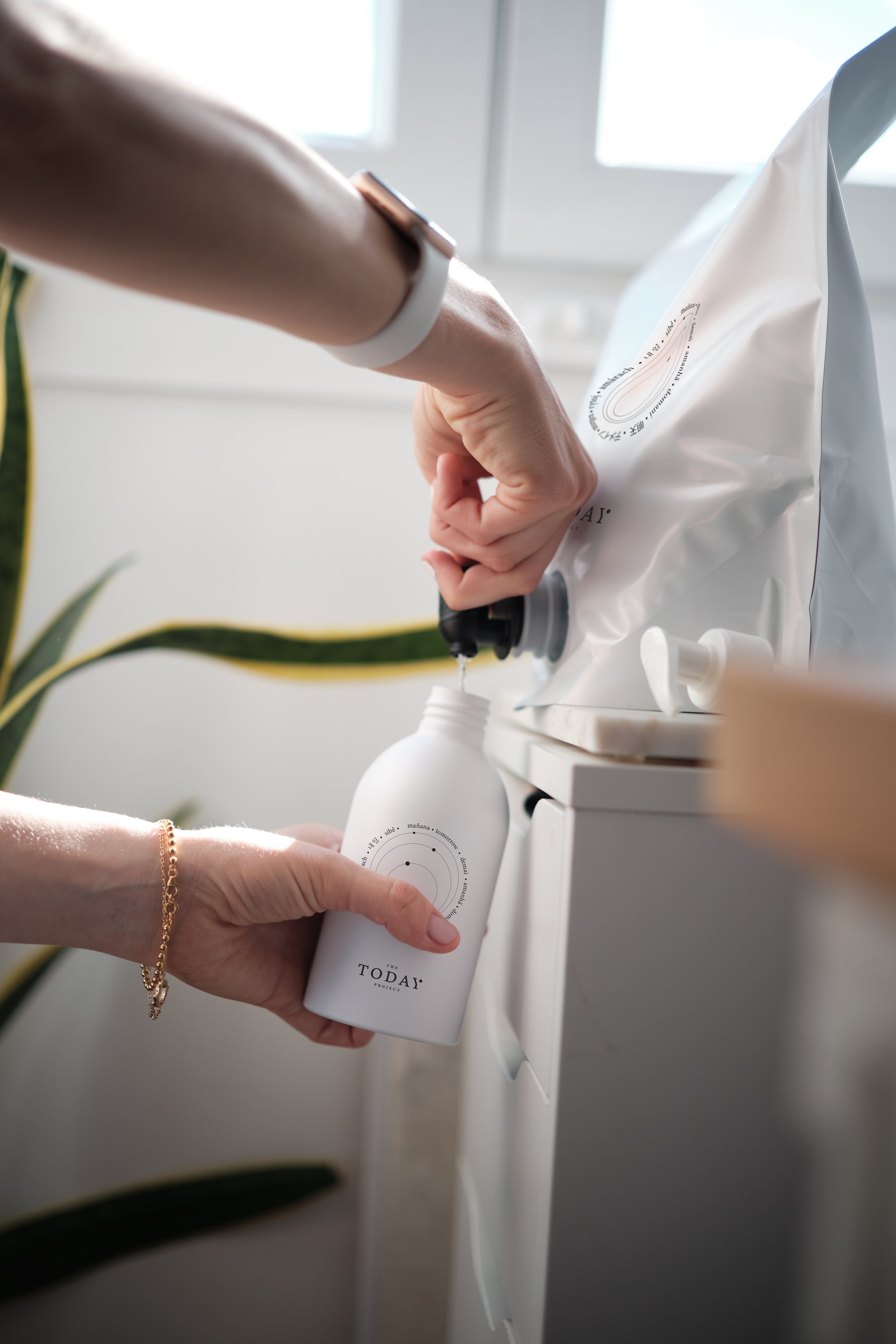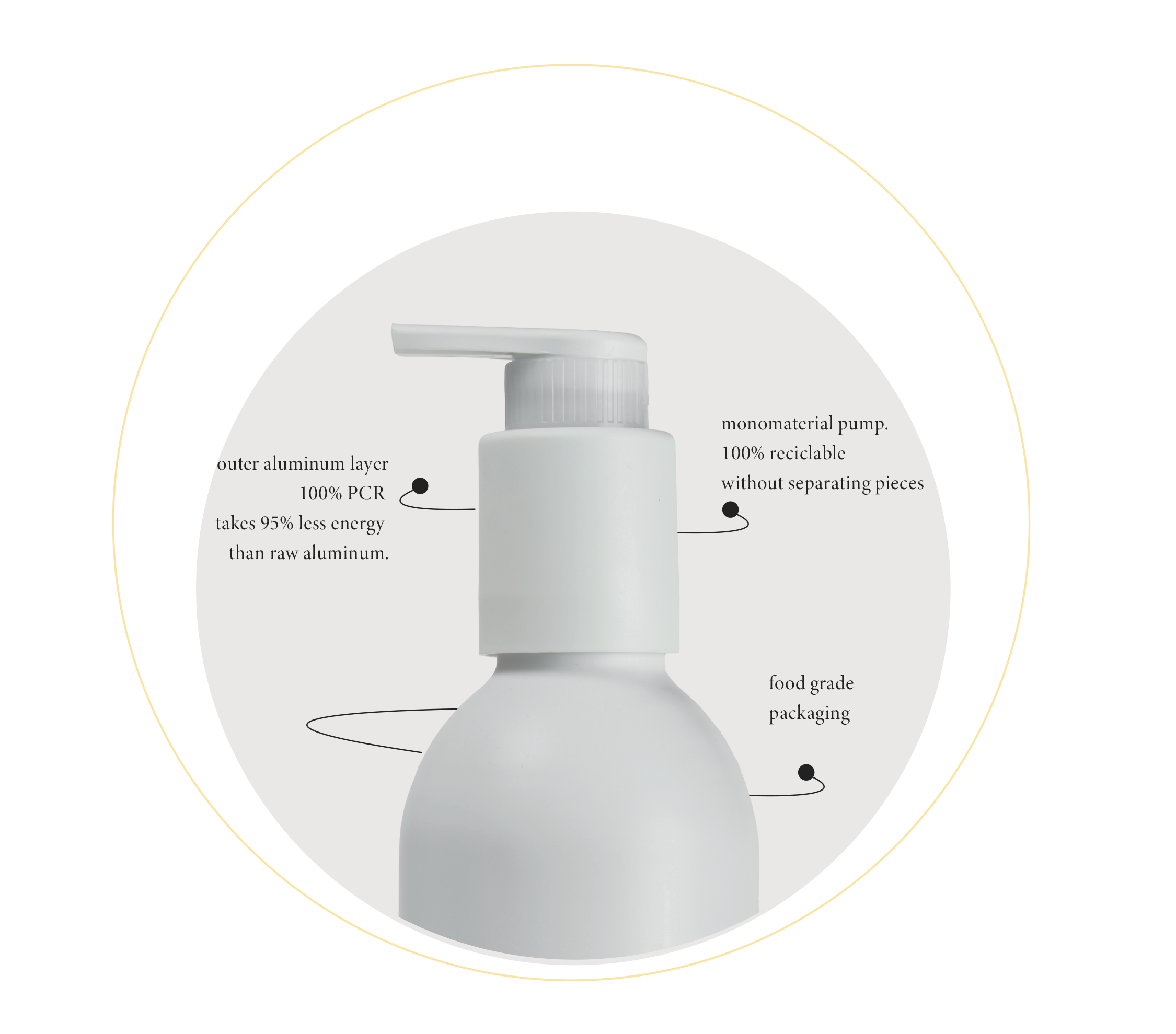Our 4 steps solution to end up plastic waste
At The Today Project, our dedication to the environment, sustainability, and the circular economy is unwavering.
Through thoughtful eco-design of our product packaging, we have curated optimal solutions that not only encourage reusability but also significantly minimize waste, thus eradicating the notion of short-lived packaging.
Our packaging comprises two key components: the product is dispensed in bulk within a returnable and reusable plastic bag, accompanied by a refillable bottle.
REFILLABLE BOTTLES
Due to its unique characteristics, recycled aluminum has become the most suitable material for our refillable containers.
2. CHOOSING ALUMINUM OVER PLASTIC

INFINITE RECYCLABILITY, LOW ENVIRONMENTAL IMPACT
In Europe, over 70% of aluminum production is achieved using clean technologies and renewable hydroelectric energy, significantly reducing its carbon footprint (1, 2). Moreover, its highly recyclable nature makes it an invaluable ally for the circular economy. Thanks to its ability to be recycled time and again without losing quality, around 75% of all aluminum ever produced is still in use. This cycle of endless recycling not only minimizes waste but also helps decrease greenhouse gas emissions. Recycling an aluminum container saves up to 95% of the energy needed to produce a new one from scratch. That's enough energy to recharge 20 smartphones! Using a ton of recycled aluminum saves approximately 16 tons of greenhouse gas emissions (3).
+70%
In the context of Europe, where environmental sustainability is a priority, it is noteworthy that a significant proportion, specifically over 70%, of aluminum production relies on the utilization of clean technologies powered by renewable hydroelectric energy.
∞
Infinite recycling.
75% of all aluminum ever produced is still in use. Recycling an aluminum container saves up to 95% of the energy needed to produce a new one from scratch. Recycling an aluminum container saves enough energy to recharge 20 smartphones.
-95%
Europe holds the highest Recycling Efficiency rate of any region in the world, recycling 81% of available aluminum waste.
Using one ton of recycled aluminum saves approximately 16 tons of greenhouse gas emissions.
ALUMINUM: LIGHTNESS, STRENGTH, AND IMPERMEABILITY
Another characteristic of aluminum is its lightweight nature. Aluminum is exceptionally lightweight and provides an effective barrier even with thicknesses of just a few microns. This means less aluminum is required per package, resulting in lower carbon emissions for each package, including transportation, compared to heavier materials like glass (5).
Where Does the Aluminum in Our Packaging Come From?
Our packaging is sourced from recycled aluminum and is certified as PCR (Post-Consumer Recycled) and PIR (Pre-Consumer Recycled).
This certification ensures that our aluminum packaging originates from recycled sources, whether from post-consumer or pre-consumer waste.
Furthermore, our aluminum suppliers are dedicated to decarbonization and are being certified by
the ASI (Aluminium Stewardship Initiative) for their environmental, social, and governance aspects.
100% PCR Our packaging is sourced from recycled aluminum and is certified as PCR (Post-Consumer Recycled) and PIR (Pre-Consumer Recycled).
BPA FREE Our aluminum bottles are crafted without the use of BPA (Bisphenol A) inner coatings, ensuring a safer and more environmentally friendly option for storing your liquids.
3. MONOMATERIAL PUMP
Our dispenser is made of 100% recyclable monomaterial plastic.
Being of a single plastic type, the dispenser is easier to recycle as it does not require the separation of different material layers, thus enhancing the recycling process efficiency.
Furthermore, using monomaterial plastic entails lower resource consumption during production, resulting in reduced demand for raw materials and energy required for manufacturing the dispenser.
This helps reduce the carbon footprint and mitigate environmental impact.
4. REFILL BAGS
Our bulk bags make a significant contribution to the circular economy and the reduction of environmental impact.
Despite being made of plastic, they stand out for their efficiency: a 2-liter bag weighs only 25 grams, replacing approximately 8 conventional plastic bottles. This represents a 99% reduction in the volume of plastic waste generated.
Additionally, our bags are designed to be returned, reconditioned, and reused in the near future.
This practice promotes the circular economy and significantly reduces the environmental footprint associated with material use.
REFERENCES:
1. International Aluminium Institute. Life Cycle Inventory Data And Environmental Metrics For The Primary Aluminium Industry 2019 Data. 2022. Disponible en: https://international-aluminium.org/resource/2019-life-cycle-inventory-lci-data-and-environmental-metrics/
2. European Aluminium. Environmental Profile Report. 2018. Disponible en: https://european-aluminium.eu/wp-content/uploads/2022/10/european-aluminium-environmental-profile-report-2018-executive-summary.pdf
3. International Aluminium Institute. Aluminium Recycling Factsheet. 2020. Disponible en: https://international-aluminium.org/resource/aluminium-recycling-fact-sheet/
4. Asociación Arpal. 2018. Disponible en: https://aluminio.org/
5. Alupro. Fact Sheet 4. Carbon Footprint Of Aluminium. 2021. Disponible en: https://alupro.org.uk/sustainability/fact-sheets/
6. Coelho P.M., Corona B., Ten Klooster R., Worrell E. Sustainability of reusable packaging–Current situation and trends. Resources, Conservation & Recycling: X [Internet]. 2020;6(100037):100037. Disponible en: https://www.sciencedirect.com/science/article/pii/S2590289X20300086





